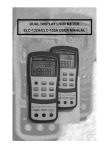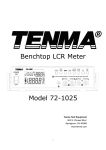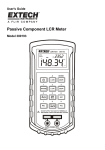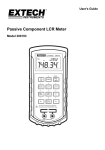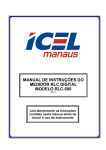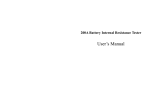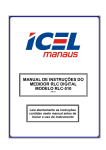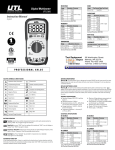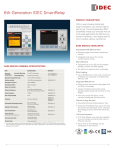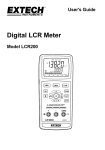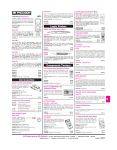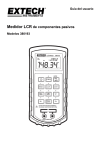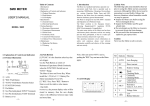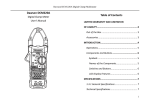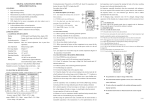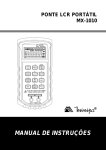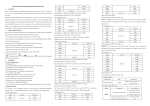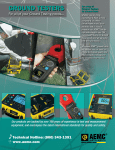Download 878A and 879 Dual Display LCR Meter
Transcript
INSTRUCTION MANUAL MANUAL DE INSTRUCCIÓNES Dual Display LCR Meter Model 878A / 879 Medidor LCR de Doble Exhibicion Visual Modelos 878A/ 879 DUAL DISPLAY L/C/R METER INSTRUCTION MANUAL Model-A = 879 Model-B = 878A 1 TABLE OF CONTENTS PAGE Safety 3 Introduction 5 Front Panel Illustration 6 LCD Display Illustration 7 How to Operate 9 Operating Instructions Data Hold Static Recording Dissipation Factor / Quality Factor/ Phase Angle Test Frequency L/C/R function selector Relative Tolerance Auto/manual ranging Automatic Fuse Detection Parallel / Series Mode Calibration Auto Power Off/ Disable Auto Power Off Low Battery Indication Backlit Display Communication 13 13 13 13 14 14 14 14 15 15 15 16 17 17 17 18 General Specification 19 Electrical Specification 20 Maintenance 28 Spanish Manual 33 2 SAFTEY Read "SAFETY INFORMATION" before using this meter. NOTE The meter is a hand-held, battery-operated instrument for testing inductance, capacitance and resistance. If this device is damaged or something is missing, contact the place of purchase immediately. This manual contains information and warnings must be followed to ensure safe operation as well as to maintain the meter in a safe condition. Some common international electrical symbols used in this manual are shown below Table: DC - Direct Current See Explanation In The Manual Table 1-1. International Electrical Symbols Before using the meter, read the following safety information carefully. In this manual, "WARNING", is reserved for conditions and actions that pose hazard(s) to the user; "CAUTION", is reserved for conditions and actions that may damage your meter. 3 SAFETY INFORMATION To ensure that you use this device safely, follow the safety guidelines listed below: • • • • • • • • This meter is for indoor use, altitude up to 2,000 m. The warnings and precautions should be read and well understood before the instrument is used. Use this device only as specified in this manual; otherwise, the protection provided by the meter may be impaired. When measuring in-circuit components, first de-energize the circuits before connecting to the test leads. Discharge capacitor before testing. The meter is safety-certified in compliance with EN61010 (IEC 1010-1) Installation Category II (CAT. II) 50 V, Pollution Degree 2 environment. Use the meter only as specified in this manual. Otherwise, the protection provided by the meter may be impaired. The power for the meter is supplied with a single standard 9V battery. But also a line operation is possible using a 12V AC to DC adaptor. If a power adaptor is selected, please be sure to use fulfilled the safety requirements of a relevant IEC standard. 4 INTRODUCTION This 19,999-count L/C/R hand-held meter is a special microprocessorcontrolled meter for measuring functions of inductance, capacitance and resistance. Extremely simple to operate, the instrument not only takes absolute parallel mode measurements, but also capable of series mode measurement. The meter provides direct and accurate measurements of inductors, capacitors and resistors with different testing frequencies. It is selectable for auto and manual ranging. Front panel pushbuttons maximize the convenience of function and feature selection such as data hold; maximum, minimum and average record mode; relative mode; tolerance sorting mode; frequency and L/C/R selection. The test data can be transferred to PC through an optional full isolated optical RS232C interface. Backlight display for easy reading in dark places (Model-A only). A tilt stand provides position flexibility for viewing and operating the meter. The over-molding rubber case protects the meter to be stronger. With single 9V battery operation is standard for the meter, a DC 12V power adaptor can also be used as an optional power input. 5 FRONT PANEL ILLUSTRATION 1. 2. 3. 4. 5. 6. 7. 8. 9. 10. 11. 12. LCD display Power ON/OFF button RS232 and Backlit button Dissipation factor, Quality factor and Phase angle selection button Test frequency selection button Inductance, Capacitance and Resistance function selection button. Parallel and series mode selection button Tolerance mode selection button Data hold, Maximum, Minimum and Average reading selection button Range selection button Relative mode and Calibration selection button DC 12V adaptor input Input sockets and Terminals 1 2 3 RS232 4 5 6 7 u u u u RS232 RS232 HOLD REC 8 9 AUTO TOL RS232 REL CAL 10 HOLD REC AUTO TOL REL CAL 11 12 Figure-1. Front panel for Model-A and Model-B. 6 LCD DISPLAY ILLUSTRATION 2 3 4 6 10 5 7 8 9 11 1 16 17 18 19 u u 20 RS232 Figure 2. LCD Display. 1. 2. 3. 4. 5. 6. 7. 8. 9. 10. 11. 12. 13. 14. 15. 16. 17. 18. AUTO: Auto-ranging indicator LCR: L, C or R function indicator MAX: Maximum reading indicator AVG: Average reading indicator REL: Relative mode indicator MIN: Minimum reading indicator DH: Data hold indicator Θ: Phase angle indicator (Model-A only ) Q: Quality factor indicator D: Dissipation factor indicator : Secondary display : Beeper tone indicator for tolerance mode %: Tolerance (percentage) indicator deg: Phase Angle degree indicator (Model-A only ) kHz: Frequency indicator MAX AVG MIN: Recording mode indicators TOL: Tolerance mode indicator 1%5%10%20%: Tolerance sorting (percent) indicator 7 12 13 14 15 21 22 23 24 25 26 19. 20. : Auto power- off indicator : Low battery indicator 21. PAL: Parallel mode indicator 22. 23. SER: Series mode indicator MkΩ: Resistance (Ohm) indicator 24. : Inductance (Henry) indicator 25. 26. : Capacitance (Farad) indicator : RS232 indicator Special Indication Characters : Indicates short connectors : Indicates open connectors : Indicates calibration mode : Indicates damaged or open fuse 8 HOW TO OPERATE Caution • When measuring within a circuit, the circuit must be deenergized before connecting the test leads. • The instrument that used in dusty environment should be wiped and cleaned regularly. • Do not leave the instrument exposed to direct heat from the sun or beat source for long periods. • Before removing the cover, ensure that the instrument is disconnected from any circuit and in power "OFF" position. Note: For achieving optimum precision for all L, C and R measurements at either the highest or lowest ranges, it is recommended to calibrate the meter before testing. 9 Inductance Measurement 1. 2. 3. 4. 5. 6. Press the "POWER" button to turn on the meter. Press “L/C/R” button to select inductance measurement. Insert an inductor into component receptacle socket or connect the test clip to the component leads as required. Press “FREQ” button to select testing frequency. Press “D/Q” button to select Q factor for secondary display. Read the display readings for inductance value and quality factor. u RS232 HOLD REC AUTO TOL REL CAL Figure-3. Inductance Measurement. 10 Capacitance Measurement 1. 2. 3. 4. 5. 6. Press "POWER" button to turn on the meter. Press “L/C/R” button to select capacitance measurement. Insert a capacitor into the component receptacle socket or connect the test clip to the component leads as required. Press “FREQ” button to select testing frequency. Press “D/Q” button to select D factor for secondary display. Read the display readings for capacitance value and dissipation factor. Warning To avoid electrical hazards, discharge the capacitor to be tested before measuring. RS232 HOLD REC AUTO TOL REL CAL Figure-4. Capacitance Measurement. 11 Resistance Measurement 1. 2. 3. 4. 5. Press "POWER" button to turn on the meter. Press “L/C/R” button to select Resistance measurement. Insert a resistor into the component receptacle socket or connect the test clip to the component leads as required. Press “FREQ” button to select testing frequency (this meter will not give you the DC resistance of a component). Read the display readings for resistance value. RS232 HOLD REC AUTO TOL REL CAL Figure-5. Resistance Measurement. 12 OPERATING INSTRUCTIONS Data Hold This data hold function allows the operator to freeze the display. To enter this mode, press the “HOLD” pushbutton; press again to release. Static Recording Press the “REC” pushbutton for more than one second to enter the static recording mode. The maximum and minimum readings are then stored in memory, while a beeping tone is produced when a new tested value has been recorded. Push the same button to cycle through the maximum, minimum and average of the present readings. The MAX, MIN or AVG indicators will display on LCD will turn on to indicate what value is being displayed. Whenever the “MAX AVG MIN” indicators appear on the LCD simultaneously, the display reading is always a present value. To exit this mode, press and hold the pushbutton for more than one second. Notes: 1. Static recording captures only stable values and updates the memory; it will not record any “OL” (overload) value for any of the L/C/R functions. In addition, the meter will not record which values are below 50 counts in Capacitance measurement. 2. Static recording is only available in manual ranging; however, activation while in auto-ranging will automatically set meter to manual ranging and cause calibration prompts to be displayed in the recommended ranges. Dissipation Factor / Quality Factor/ Phase Angle The “D/Q/Θ” value can be displayed interchangeably by pressing the “D/Q/Θ” button when the meter is set to Inductance or Capacitance mode. It does not apply to resistance measurement. The phase angle is available on Model-A only. 13 Test Frequency Default testing frequency is 1KHz. Push “FREQ” key to select the desired test frequency. L/C/R Function Selector Simply press the “L/C/R” pushbutton to select the desired L, C or R function. Relative Press the “REL” key to enter the relative mode and stores the display reading as a reference value. It will then display all subsequent readings in relative to reference value. Press the button again to exit the relative mode. Notes: 1. The relative mode can’t be activated if the display value is either “OL” or “0000”. 2. Relative mode is only available in manual ranging; however, activation while in auto-ranging will automatically set the meter to manual ranging and cause calibration prompts to be displayed in the recommended ranges. 3. The relative mode cannot be activated if the meter is set at autoranging with data hold activated. Tolerance There are 1%, 5%, 10% and 20% tolerance range. To enter this tolerance mode, insert the appropriate component as a standard value into the socket or connect the component to the test probes, then press the “TOL” pushbutton to set this value, as the standard reference tolerance. Similarly, any value which appears on the LCD display, such as DH or MAX/MIN/AVG, can be used as a standard value to sort components. Press this button again to cycle through 1%, 5%, 10% and 20% tolerance as desire. This function is designed for convenient component sorting. An audible tone will sound whenever the component under test exceeds the setting 14 tolerance. Conversely, a single tone of “Be” indicates the component is within the setting tolerance. Notes: 1. The tolerance mode can’t be activated if the tested display is either “OL” or “0000”; nor can it be activated the tested capacitance value is below 10 counts. 2. Tolerance mode is only available in manual ranging; however, activation while in auto-ranging will automatically set the meter to manual ranging and cause calibration prompts to be displayed in the recommended ranges. 3. The tolerance mode can’t be activated if the meter is set at autoranging with data hold mode activated. 4. For 20% selection is available on Model-A only. Auto / Manual Range The auto-ranging mode is default status when the meter is powered on. For specific measurement, press “AUTO” button to select manual ranging. To return to the auto-ranging mode, press and hold the “AUTO” button for more than one second. Automatic Fuse Detection When the meter detects that the protective fuse is open, the “FUSE” character will appear and an internal beep will sound continuously. In this situation, none of the function keys can be operated and all other meter functions will be discontinued. Fuse replacement is required. Figure-6. Fuse Detection Parallel / Series Mode The meter is capable of displaying Parallel and Series mode data for all ranges. The parallel mode is default for Capacitance and Resistance 15 measurements, and the series mode is default for Inductance measurement. Press “L/C/R” button for more than 1 second to toggle “SER” and “PAL” mode. Calibration Calibration is available to all ranges. Simply press and hold “CAL” button for more than one second to enter the calibration mode and calibration prompts will be displayed. Follow the prompts for open connector ( ) or short connector ( ) connection and press the “CAL” button. After calibration is completed, the meter will be restored to normal display and ready for normal usage. Figure-7. Open/ Short Calibration The function calibrates the meter’s internal parameters as well as external connector residues for further measuring. It is highly recommended to calibrate extremely high or low ranges for L, C and R before making precision measurements. Calibration prompts will be displayed automatically every time those ranges are manually or functionally selected, (e.g. REL, TOL, REC etc.), and calibration is recommended. Simply follow the open connector ( ) or short connector ( ) instruction and then press the “CAL” button. You may skip the calibration by pressing the “D/Q” button. Notes: 1. Changing measurement frequencies is handled the same as selecting a different hardware range, and so automatic calibration prompts will be displayed in the recommended ranges. 16 2. Be sure to use same testing position after short calibration. Auto Power Off/ Disable Auto Power Off When the meter has not been used for five minutes after the last operation was made, a long “beep” tone will sound. The meter will then automatically enter a “sleep” mode and there will be no display on the LCD. To reactivate the meter, simply press any pushbutton. After reactivating. When the meter is to be used for long period, the auto power-off can be disabled by pressing and holding “L/C/R” button while turning meter ON. Release the button, and press any button again. The symbol will be disappeared to confirm that the auto power off has been disabled. By using a 12V AC adaptor as an optional power source, auto power off is disabled automatically. Note: It is recommended that the meter should always be switched off when not in use. Low Battery Indication When the “ “ symbol flashes on the display, the battery voltage is below normal working voltage and is weakening. Replace battery with a new one to maintain accuracy of the meter. Backlit Display (Model-A only) Press and hold “ “ key for more than one second to toggle backlit ON/OFF. 17 Communication This meter has communication capability. By using the optional RS232 package (AK 87X), with full optical isolated cable and software. This function will assist user to record data easily. Referring the following procedures to set up the communication between your meter and personal computer. 1. 2. 3. 4. Fixes one side of cable to the meter, and the text side shall be facing up. To connect the 9-pin’s terminal of cable to communication port 1 or 2 of personal computer. See the Figure8. Press “RS232” button to enable this interface. You will find that the symbol of “ ” is lit on the display. Execute the software to take the data for your applications. Be sure to push the snap ends on the cable of meter side for removing the cable. The text side shall be facing Figure-8. Cable Connection Of Communication 18 GENERAL SPECIFICATION Items Parameters Measured Measuring Circuit Mode Displays Ranging Mode Measuring Terminals Test Frequency Accuracy: ±0.1 % Backlit display Tolerance mode Test Signal Level Measuring Rate Response time 879 878A L/C/R/D/Q/Θ L/C/R/D/Q Inductance (L) –Defaults to series mode Capacitance/ Resistance (C/R) -Defaults to parallel mode L/C/R: Maximum display 19999 D/Q: Maximum display 999 (Auto Range). Auto & Manual 3 terminals with sockets 100Hz=100 Hz 120Hz= 120 Hz 120Hz= 120 Hz 1KHz =1010 Hz 1KHz =1010 Hz 10KHz= 9.6 KHz Included Excluded 1%, 5%, 10%, 20% 1%, 5%, 10% 0.6Vrms approx. 1 time/second, nominal Approx. 1 second/ DUT (device under test)(@ manual range) Auto Power-Off Temperature Coefficient 5 minutes approx. without operation 0.15 x (Specified Accuracy) / °C(0-18° or 28-40°) Operation Temperature Storage Temperature Low Battery Indication Power Consumption 0°C to 40°C; 0-70% R.H. -20°C to +50°C; 0-80% R.H. Approx. 6.8V Approx. 40mA for operation/ 0.08mA after Auto Power-off. 1) DC 9V Battery 2) Ext. DC Adaptor: DC 12Vmin –15Vmax. (Load 50mA Min.) 0.1A/250V Fuse (input protective) Test alligator clips (pair) DC 9V Battery. User manual 7.2 x 3.4 x 1.6” (184 x 87 x 41 mm) 11.6oz (330 grams) Power Requirements Protective Fuse Standard Accessories Dimensions (L/W/H) Weight 19 ELECTRICAL SPECIFICATIONS Accuracy is expressed as: ± (% of reading + no. of least significant digits) at 23℃±5℃and <75% R.H. Model 879: Resistance (Parallel mode) Test Frequency: 100 / 120 Hz Maximum Range Display Accuracy @100 Hz @120Hz Specified Note 10MΩ 9.999MΩ 2.0%+8 *3 2.0%+8 *3 After open cal. 2000KΩ 1999.9KΩ 0.5%+5 0.5%+5 After open cal. 200KΩ 199.99KΩ 0.5%+3 0.5%+3 - 20KΩ 19.999KΩ 0.5%+3 0.5%+3 - 2000Ω 1999.9Ω 0.5%+3 0.5%+3 - 200Ω 199.99Ω 0.8%+5 0.8%+5 After short cal. 20Ω 19.999Ω 1.2%+40 1.2%+40 After short cal. Test Frequency: 1K / 10K Hz Maximum Accuracy Range Display @1K Hz @10KHz Specified Note 10 MΩ 9.999MΩ 2.0%+8 * 3 3.5%+10 * 3 After open cal. 2000 KΩ 1999.9KΩ 0.5%+5 2.0%+10 After open cal. 200 KΩ 199.99KΩ 0.5%+3 1.5%+5 - 20 KΩ 19.999KΩ 0.5%+3 1.5%+5 - 2000 Ω 1999.9 Ω 0.5%+3 1.5%+5 - 200 Ω 199.99 Ω 0.8%+5 2.0%+10 After short cal. 20 Ω 19.999 Ω 1.2%+40 2.5%+200 After short cal. Notes: 1. This specification is based on the measurement performed at the test socket. 2. DUT (Device Under Test) & Test leads be properly shielded to GUARD if necessary. 3. This specification is based on battery operation. 20 Capacitance (Parallel mode) Test Frequency: 100 / 120 Hz Accuracy Range Maximum Display Capacitance DF 10mF 19.99mF *5 3.0%+5 10%+100/Cx+5 (DF<0.1) (DF<0.1) 1000μF 1999.9μF*6 200μF 199.99μF 20μF 19.999μF 2000nF 1999.9nF 200nF 199.99nF 20nF 19.999nF Test Frequency: 1 KHz Range Maximum Display 1mF 1.999mF *5 200μF 199.99μF 20μF 19.999μF 2000nF 1999.9nF 200nF 199.99nF 20nF 19.999nF 2000pF 1999.9pF 1.0%+5 (DF<0.1) 0.7%+3 DF<0.5 0.7%+3 (DF<0.5) 0.7%+3 (DF<0.5) 0.7%+5 (DF<0.5) 1.0%+5 (DF<0.1) 2%+100/Cx+5 (DF<0.1) 0.7%+100/Cx+5 (DF<0.5) 0.7%+100/Cx+5 (DF<0.5) 0.7%+100/Cx+5 (DF<0.5) 0.7%+100/Cx+5 (DF<0.5) 2%+100/Cx+5 (DF<0.1) Accuracy Capacitance 3.0%+5 (DF<0.1) 1.0%+5 (DF<0.1) 0.7%+3 (DF<0.5) 0.7%+3 (DF<0.5) 0.7%+3 (DF<0.5) 0.7%+5 (DF<0.5) 1.0%+5 (DF<0.1) 21 DF 10%+100/Cx+5 (DF<0.1) 2.0%+100/Cx+5 (DF<0.1) 0.7%+100/Cx+5 (DF<0.5) 0.7%+100/Cx+5 (DF<0.5) 0.7%+100/Cx+5 (DF<0.5) 0.7%+100/Cx+5 (DF<0.5) 2.0%+100/Cx+5 (DF<0.1) Spec. Note After short cal. After short cal. After open cal. After open cal. Spec. Note After short cal. After short cal. After open cal. After open cal. Test Frequency: 10 KHz Maximum Accuracy Range Display Capacitance DF Spec. Note 50μF 50.0μF 3.0%+8 (DF<0.1) 12%+100/Cx+10 (DF<0.1) After short cal. 20μF 19.999μF 3.0%+6 (DF<0.2) 5.0%+100/Cx+8 (DF<0.2) After short cal. 2000nF 1999.9nF 1.5%+5 (DF<0.5) 1.5%+100/Cx+6 (DF<0.5) - 200nF 199.99nF 1.5%+5 (DF<0.5) 1.5%+100/Cx+6 (DF<0.5) - 20nF 19.999nF 1.5%+5 (DF<0.5) 1.5%+100/Cx+6 (DF<0.5) - 2000pF 1999.9pF 2.0%+6 3.0%+100/Cx+6 (DF<0.5) After open cal. (DF<0.5) 3.0%+8 (DF<0.1) 5.0%+100/Cx+8 (DF<0.1) After open cal. 200pF 199.99pF Notes: 1. Q Value is the reciprocal of DF. 2. This specification is based on the measurement performed at the test socket. 3. DUT & Test leads should be properly shielded to GUARD if necessary. 4. Cx=Counts of displayed C value, e.g. C=88.88μF then Cx=8888. 5. This reading can be extended to 1999 MAX display with accuracy not specified. 6. This reading can be extended to 19999 MAX display with accuracy not specified. 22 Inductance (Series mode) Test Frequency: 100 / 120Hz Maximum Accuracy (DF<0.5) Range Display Inductance DF 1000H 999.9H 1.0%+(Lx Spec. Note 2%+100/Lx+5 After open cal. 0.7%+(Lx /10000)%+5 1.2%+100/Lx+5 - 0.7%+(Lx 1.2%+100/Lx+5 - /10000) %+5 200H 199.99H 20H 19.999H /10000)%+5 2000m 1999.9mH 0.7%+(Lx /10000)%+5 1.2%+100/Lx+5 - 200mH 199.99mH 1.0%+(Lx /10000)%+5 3%+100/Lx+5 After short cal. 20mH 19.999mH 2.0%+(Lx /10000)%+5 10%+100/Lx+5 After short cal. Test Frequency: 1 KHz Maximum Range Display 100H 99.99H Accuracy (DF<0.5) Inductance DF 1.0%+(Lx Spec. Note 2.0%+100/Lx+5 After open cal. /10000) %+5 20H 19.999H 0.7%+(Lx /10000)%+5 1.2%+100/Lx+5 - 2000mH 1999.9mH 0.7%+(Lx /10000)%+5 1.2%+100/Lx+5 - 200mH 199.99mH 0.7%+(Lx /10000)%+5 1.2%+100/Lx+5 - 20mH 19.999mH 1.0%+(Lx /10000)%+5 3.0%+100/Lx+5 After short cal. 2000µH 1999.9µH 2.0%+ (Lx/10000)%+5 10%+100/Lx+5 After short cal. 23 Test Frequency: 10 KHz Maximum Display Range Accuracy (DF<0.5) Inductance DF Spec. Note 1000mH 999.9mH 2.0%+(Lx /10000)%+ 8 2.0%+100/Lx+10 - 200mH 199.99mH 1.5%+(Lx /10000)%+8 2.0%+100/Lx+10 - 20mH 19.999mH 1.5%+(Lx /10000)%+10 3.0 %+100/Lx+15 - 2000µH 1999.9µH 2.0%+(Lx /10000)%+10 8.0 %+100/Lx+20 After short cal. Notes: 1. 1.Q Value is the reciprocal of DF. 2. This specification is based on the measurement performed at the test socket. 3. DUT & Test leads shall be properly shielded to GUARD if necessary. 4. Lx=counts of displayed L value, e.g. L=88.88H, then Lx=8888. 24 Model 878A: Resistance (parallel mode) Test Frequency: 120Hz / 1KHz Accuracy Range Maximum Display @120 Hz @1KHz 2.0%+8 *3 2.0%+8 *3 10MΩ 9.999MΩ 0.5%+5 0.5%+5 2000KΩ 1999.9KΩ 0.5%+3 0.5%+3 200KΩ 199.99KΩ 0.5%+3 0.5%+3 20KΩ 19.999KΩ 0.5%+3 0.5%+3 2000Ω 1999.9Ω 0.8%+5 0.8%+5 200Ω 199.99Ω 1.2%+40 1.2%+40 20Ω 19.999Ω Specified Note After open cal. After open cal. After short cal. After short cal. Notes: 1. 2. 3. This specification is based on the measurement performed at the test socket. DUT (Device Under Test) & Test leads be properly shielded to GUARD if necessary. This specification is based on battery operation. Capacitance (parallel mode) Test Frequency: 120 Hz Range Maximum Display 10mF 19.99mF *5 1000μF 1999.9μF*6 200μF 199.99μF 20μF 19.999μF 2000nF 1999.9nF 200nF 199.99nF 20nF 19.999nF Accuracy Capacitance 3.0%+5 (DF<0.1) 1.0%+5 (DF<0.1) 0.7%+3 DF<0.5 0.7%+3 (DF<0.5) 0.7%+3 (DF<0.5) 0.7%+5 (DF<0.5) 1.0%+5 (DF<0.1) 25 DF 10%+100/Cx+5 (DF<0.1) 2%+100/Cx+5 (DF<0.1) 0.7%+100/Cx+5 (DF<0.5) 0.7%+100/Cx+5 (DF<0.5) 0.7%+100/Cx+5 (DF<0.5) 0.7%+100/Cx+5 (DF<0.5) 2%+100/Cx+5 (DF<0.1) Spec. Note After short cal. After short cal. After open cal. After open cal. Test Frequency: 1 KHz Range Maximum Display 1mF 1.999mF *5 200μF 199.99μF 20μF 19.999μF 2000nF 1999.9nF 200nF 199.99nF 20nF 19.999nF 2000pF 1999.9pF Accuracy Capacitance 3.0%+5 (DF<0.1) 1.0%+5 (DF<0.1) 0.7%+3 (DF<0.5) 0.7%+3 (DF<0.5) 0.7%+3 (DF<0.5) 0.7%+5 (DF<0.5) 1.0%+5 (DF<0.1) DF 10%+100/Cx+5 (DF<0.1) 2.0%+100/Cx+5 (DF<0.1) 0.7%+100/Cx+5 (DF<0.5) 0.7%+100/Cx+5 (DF<0.5) 0.7%+100/Cx+5 (DF<0.5) 0.7%+100/Cx+5 (DF<0.5) 2.0%+100/Cx+5 (DF<0.1) Spec. Note After short cal. After short cal. After open cal. After open cal. Notes: 1. Q Value is the reciprocal of DF. 2. This specification is based on the measurement performed at the test socket. 3. DUT & Test leads should be properly shielded to GUARD if necessary. 4. Cx=Counts of displayed C value, e.g. C=88.88μF then Cx=8888. 5. This reading can be extended to 1999 MAX display with accuracy not specified. 6. This reading can be extended to 19999 MAX display with accuracy not specified. NOTE: Specifications and information are subject to change without notice. Please visit www.bkprecision.com for the most current product information. 26 Inductance (Series mode) Test Frequency: 120Hz Range Maximum Display 1000H 999.9H 200H 199.99H 20H 19.999H 2000m 1999.9mH 200mH 199.99mH 20mH 19.999mH Test Frequency: 1 KHz Range Maximum Display 100H 99.99H 20H 19.999H 2000mH 1999.9mH 200mH 199.99mH 20mH 19.999mH 2000µH 1999.9µH Accuracy (DF<0.5) Inductance DF 1.0%+(Lx 2%+100/Lx+5 /10000) %+5 0.7%+(Lx 1.2%+100/Lx+5 /10000)%+5 0.7%+(Lx 1.2%+100/Lx+5 /10000)%+5 0.7%+(Lx 1.2%+100/Lx+5 /10000)%+5 1.0%+(Lx 3%+100/Lx+5 /10000)%+5 2.0%+(Lx 10%+100/Lx+5 /10000)%+5 Accuracy (DF<0.5) Inductance DF 1.0%+(Lx 2.0%+100/Lx+5 /10000) %+5 0.7%+(Lx 1.2%+100/Lx+5 /10000)%+5 0.7%+(Lx 1.2%+100/Lx+5 /10000)%+5 0.7%+(Lx 1.2%+100/Lx+5 /10000)%+5 1.0%+(Lx 3.0%+100/Lx+5 /10000)%+5 2.0%+ 10%+100/Lx+5 (Lx/10000)%+5 Spec. Note After open cal. After short cal. After short cal. Spec. Note After open cal. After short cal. After short cal. Notes: 1. Q Value is the reciprocal of DF. 2. This specification is based on the measurement performed at the test socket. 3. DUT & Test leads shall be properly shielded to GUARD if necessary. 4. Lx=counts of displayed L value, e.g. L=88.88H, then Lx=8888. 27 MAINTENANCE WARNING To avoid electrical shock, do not perform any service unless you are qualified to do so. SERVICE If the instrument fails to operate, to check battery and test leads, and replaces them if necessary. If the instrument still can’t work, double check operating procedure as described in this instruction manual. When servicing, use specified replacement parts only. The meter must be completely turned off while replacing either the fuse or battery. Battery Replacement The meter is powered a single 9V battery, with NEDA1604, JIS006P, IEC6F22 carbon-zinc or alkaline battery. Replace battery if the low battery sign ( ) is displayed and flashing. Use the following procedures to replace the battery: 1. 2. Loosen screws with suitable screwdriver and remove battery cover as Figure-9. Replace the degraded battery with a new battery. Figure-9. Battery Replacement. 28 Fuse Replacement The meter can self-detect if its input protective fuse is either open or damaged. In this case, the LCD will display the symbol "FUSE" and an audible beep will sounds continuously, warning the user to replace the damaged fuse to maintain the accuracy of measurement. While replacing the fuse, the power of the meter must be completely shut off. 1. 2. 3. Loosen screws with suitable screwdriver and remove battery cover as Figure-9. Loosen screws with suitable screwdriver and remove bottom cover as Figure-10. Replace the damaged fuse with specified one. Figure-10. Fuse Replacement 29 Cleaning the Meter WARNING To avoid electrical shock or damaging the meter, never get water inside the case. Before cleaning this meter, make sure the power is switched in OFF position and remove external DC adaptor. To clean the meter, wipe the dirty parts with gauze or soft cloth soaked with diluted neutral detergent. Do not get too wet to prevent the detergent from penetrating into inside parts and causing damages. After cleaning, make sure the instrument is dried completely before using. 30 Limited One-Year Warranty B&K Precision Corp. warrants to the original purchaser that its products and the component parts thereof, will be free from defects in workmanship and materials for a period of one year from date of purchase. B&K Precision Corp. will, without charge, repair or replace, at its option, defective product or component parts. Returned product must be accompanied by proof of the purchase date in the form of a sales receipt. To obtain warranty coverage in the U.S.A., this product must be registered by completing a warranty registration form on www.bkprecision.com within fifteen (15) days of purchase. Exclusions: This warranty does not apply in the event of misuse or abuse of the product or as a result of unauthorized alterations or repairs. The warranty is void if the serial number is altered, defaced or removed. B&K Precision Corp. shall not be liable for any consequential damages, including without limitation damages resulting from loss of use. Some states do not allow limitations of incidental or consequential damages. So the above limitation or exclusion may not apply to you. This warranty gives you specific rights and you may have other rights, which vary from state-to-state. B&K Precision Corp. 22820 Savi Ranch Parkway Yorba Linda, CA 92887 www.bkprecision.com 714-921-9095 31 Service Information Warranty Service: Please return the product in the original packaging with proof of purchase to the address below. Clearly state in writing the performance problem and return any leads, probes, connectors and accessories that you are using with the device. Non-Warranty Service: Return the product in the original packaging to the address below. Clearly state in writing the performance problem and return any leads, probes, connectors and accessories that you are using with the device. Customers not on open account must include payment in the form of a money order or credit card. For the most current repair charges please visit www.bkprecision.com and click on “service/repair”. Return all merchandise to B&K Precision Corp. with pre-paid shipping. The flat-rate repair charge for Non-Warranty Service does not include return shipping. Return shipping to locations in North American is included for Warranty Service. For overnight shipments and non-North American shipping fees please contact B&K Precision Corp. B&K Precision Corp. 22820 Savi Ranch Parkway Yorba Linda, CA 92887 www.bkprecision.com 714-921-9095 Include with the returned instrument your complete return shipping address, contact name, phone number and description of problem. 32 22820 Savi Ranch Parkway Yorba Linda, California 92887 www.bkprecision.com ©2006 B&K Precision Corporation Printed in 481-524-9-001 33


































